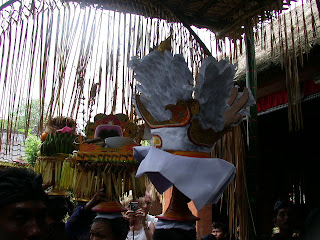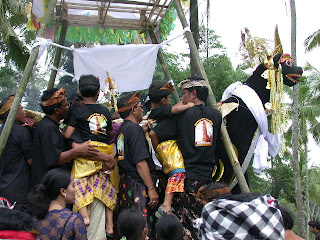The next morning, I got a cab to take me to the village. I asked the cab driver if he knew about the cremation. He didn't. He dropped me off at the village and I walked round looking for a house that stood out from the rest. I was getting a little worried if I was in the right place. After all, I had only heard of the cremation from the gamelan players and they weren't very precise with the details. Perhaps they were mistaken.
But I walked down a few roads looking at the rows of houses and trying hard to pick up something that might indicate that it was a house of mourning.
 I didn't have to go very far before I saw this - the golden calf - and I knew I just had to stick around.
I didn't have to go very far before I saw this - the golden calf - and I knew I just had to stick around.I could identify the house which had a flurry of activity. There were very loud and garish decorations in the house which were filled with people walking in and out. I looked around me and I spotted an elderly Caucasian couple. They were Americans and the husband was a Christian missionary in Bali and they had lived in Bali for three of four years. They had come to witness the cremation. I asked them if they would like to accompany me into the house just to get to know the family. I felt it wasn't right to just gatecrash a funeral. Surely the least we should do was to convey our condolences to the family? The elderly woman said they didn't speak a word of Indonesian and they would just stand around and wait. So I proceeded into the house.
I spoke to somebody who looked like he was directly related to the deceased and I asked him in Bahasa Indonesia if I could convey my condolences to the family. He took me into the house and I was introduced to the wife of the deceased and the rest of the family. What puzzled me was everyone was in good spirits and there was no mourning at all. They were all smiling and joking. I was told that the deceased died many months ago and they had kept the body for this cremation day. A funeral was a happy occasion, they told me.
It's not easy for me to go to a house of mourning because I can't remain mournful for long. But a Balinese funeral is not in any way mournful. Soon, I was joking along with the family. They told me that the procession was about to start. They would be taking the body to the cremation ground. Everyone was leaving the house carrying food offerings for the dead. I asked the family if it was all right for me to take photographs. They told me I was more than welcome to take as many photos as I wanted. That was the green light I was waiting for. I couldn't just take photos of a funeral without the express permission of the deceased's family.
I left the house together with everyone else. The American couple were nowhere to be seen. Perhaps they felt uneasy and had gone off. That meant I was the only outsider in the entire village. But I felt quite at home with the people. And I really put my camera to work.
This decorative structure forms a part of the funeral procession.

There are lot of people at the funeral and they all seemed to have their own roles to play.

A priest blessing some of the attending ladies.

The house of the deceased's family.


There are dozens of ladies carrying on their heads food offerings for the dead




The person who is dressed in this horrid looking mask and attire is the grown-up son of the deceased. He is walking on stilts. It's probably a part of the funeral ritual.

More food offerings

The coffin is being moved from the house to the hearse.



Another son of the deceased dresses up as this monster, probably some character in a story from the Ramayana.



The village musicians.


This is the unsheathed machete I was talking about in my earlier posts. It's the sort of photograph I fancy National Geographic might take an interest in.

The funeral procession.

We arrive at the cremation ground.

The village gossips, I mean, minstrels.

The musicians make themselves comfortable on the grass

The deceased receiving a final blessing from the priest




The grandchildren are taken to see their grandpa for one last time. Interestingly, nobody sheds a tear, not even the children. We have a lot to learn from them. For many of us who claim we believe in life after death, we certainly don't behave that way at funerals.

Village musicians and singers taking a rest

The funeral pyre is lit

The body is still on top of the golden calf


The body has collapsed to the lower level - under the calf.

The skull takes a very long time to burn

The 4th and final part of this series will be written when I'm next in Bali, the Island of the Gods.
No comments:
Post a Comment